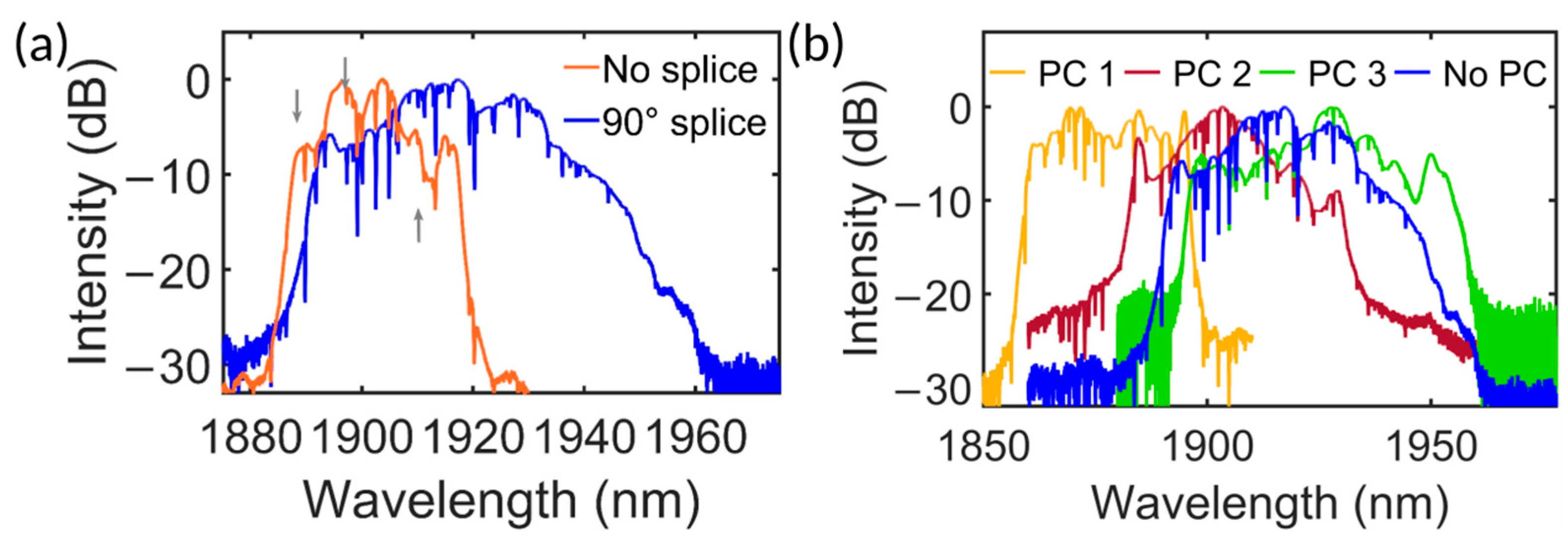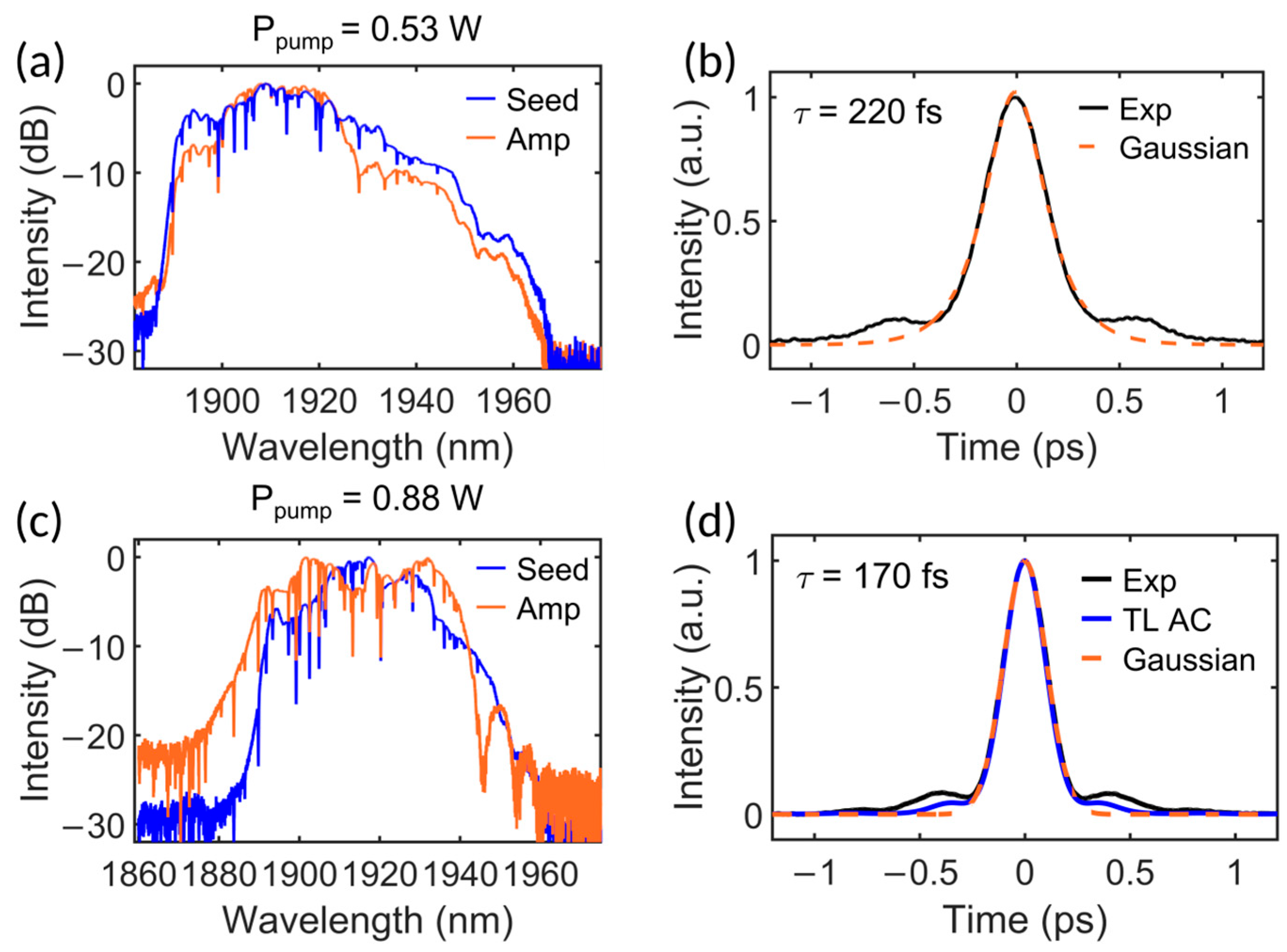Sub-200 fs Polarization-Maintaining All-Fiber Thulium-Doped Dissipative Soliton Fiber Laser System at 1920 nm
Abstract
1. Introduction
2. Materials and Methods
3. Results
4. Discussion
Author Contributions
Funding
Data Availability Statement
Conflicts of Interest
References
- Rudy, C.W.; Digonnet, M.J.F.; Byer, R.L. Advances in 2-µm Tm-Doped Mode-Locked Fiber Lasers. Opt. Fiber Technol. 2014, 20, 642–649. [Google Scholar] [CrossRef]
- Leindecker, N.; Marandi, A.; Byer, R.L.; Vodopyanov, K.L.; Jiang, J.; Hartl, I.; Fermann, M.; Schunemann, P.G. Octave-Spanning Ultrafast OPO with 26–61 µm Instantaneous Bandwidth Pumped by Femtosecond Tm-Fiber Laser. Opt. Express 2012, 20, 7046. [Google Scholar] [CrossRef] [PubMed]
- Kopyeva, M.S.; Filatova, S.A.; Kamynin, V.A.; Trikshev, A.I.; Kozlikina, E.I.; Astashov, V.V.; Loschenov, V.B.; Tsvetkov, V.B. Ex Vivo Exposure to Soft Biological Tissues by the 2-µm All-Fiber Ultrafast Holmium Laser System. Appl. Sci. 2022, 12, 3825. [Google Scholar] [CrossRef]
- Agger, S.D.; Povlsen, J.H. Emission and Absorption Cross Section of Thulium Doped Silica Fibers. Opt. Express OE 2006, 14, 50–57. [Google Scholar] [CrossRef]
- Keller, U.; Weingarten, K.J.; Kartner, F.X.; Kopf, D.; Braun, B.; Jung, I.D.; Fluck, R.; Honninger, C.; Matuschek, N.; Aus Der Au, J. Semiconductor Saturable Absorber Mirrors (SESAM’s) for Femtosecond to Nanosecond Pulse Generation in Solid-State Lasers. IEEE J. Sel. Top. Quantum Electron. 1996, 2, 435–453. [Google Scholar] [CrossRef]
- Set, S.Y.; Yaguchi, H.; Tanaka, Y.; Jablonski, M. Laser Mode Locking Using a Saturable Absorber Incorporating Carbon Nanotubes. J. Light. Technol. 2004, 22, 51–56. [Google Scholar] [CrossRef]
- Dai, L.; Huang, Z.; Huang, Q.; Zhao, C.; Rozhin, A.; Sergeyev, S.; Al Araimi, M.; Mou, C. Carbon Nanotube Mode-Locked Fiber Lasers: Recent Progress and Perspectives. Nanophotonics 2020, 10, 749–775. [Google Scholar] [CrossRef]
- Hänsel, W.; Hoogland, H.; Giunta, M.; Schmid, S.; Steinmetz, T.; Doubek, R.; Mayer, P.; Dobner, S.; Cleff, C.; Fischer, M.; et al. All Polarization-Maintaining Fiber Laser Architecture for Robust Femtosecond Pulse Generation. In Exploring the World with the Laser; Meschede, D., Udem, T., Esslinger, T., Eds.; Springer International Publishing: Cham, Switzerland, 2018; pp. 331–340. ISBN 978-3-319-64345-8. [Google Scholar]
- Filatova, S.; Kamynin, V.; Korobko, D.; Fotiadi, A.; Lobanov, A.; Zverev, A.; Balakin, P.; Gladush, Y.; Krasnikov, D.; Nasibulin, A.; et al. Experimental and Numerical Study of Different Mode-Locking Techniques in Holmium Fiber Laser with a Ring Cavity. Opt. Express 2024, 32, 22233. [Google Scholar] [CrossRef]
- Hofer, M.; Fermann, M.E.; Haberl, F.; Ober, M.H.; Schmidt, A.J. Mode Locking with Cross-Phase and Self-Phase Modulation. Opt. Lett. 1991, 16, 502. [Google Scholar] [CrossRef]
- Tamura, K.; Haus, H.A.; Ippen, E.P. Self-Starting Additive Pulse Mode-Locked Erbium Fibre Ring Laser. Electron. Lett. 1992, 28, 2226. [Google Scholar] [CrossRef]
- Fermann, M.E.; Haberl, F.; Hofer, M.; Hochreiter, H. Nonlinear Amplifying Loop Mirror. Opt. Lett. 1990, 15, 752. [Google Scholar] [CrossRef] [PubMed]
- Ren, B.; Li, C.; Wang, T.; Guo, K.; Zhou, P. All-Polarization-Maintaining Figure-9 Mode-Locked Tm-Doped Fiber Laser With Amplitude Noise and Timing Jitter Suppression. J. Light. Technol. 2023, 41, 733–738. [Google Scholar] [CrossRef]
- Wang, M.; Liu, M.; Zhao, J.; Chen, Y.; Ouyang, D.; Ruan, S. Stable Femtosecond Pulse Generation Relying on a Simple NALM-Based All PM Tm-Doped Fiber Laser. Results Opt. 2022, 9, 100297. [Google Scholar] [CrossRef]
- Sobon, G.; Sotor, J.; Pasternak, I.; Krajewska, A.; Strupinski, W.; Abramski, K.M. All-Polarization Maintaining, Graphene-Based Femtosecond Tm-Doped All-Fiber Laser. Opt. Express 2015, 23, 9339. [Google Scholar] [CrossRef]
- Zhang, N.; Jiang, W.; Meng, Y.; Wang, F. All-Polarization-Maintaining Mode-Locked Thulium-Doped Femtosecond Laser at 1.7 µm. Opt. Contin. 2023, 2, 1013. [Google Scholar] [CrossRef]
- Sotor, J.; Bogusławski, J.; Martynkien, T.; Mergo, P.; Krajewska, A.; Przewłoka, A.; StrupiŃski, W.; SoboŃ, G. All-Polarization-Maintaining, Stretched-Pulse Tm-Doped Fiber Laser, Mode-Locked by a Graphene Saturable Absorber. Opt. Lett. 2017, 42, 1592. [Google Scholar] [CrossRef]
- Zhou, J.; Qi, W.; Zeng, X.; Cheng, X.; Jiang, H.; Cui, S.; Feng, Y. All-Polarization-Maintaining, Ultra-Compact Tm-Doped Fiber Laser Designed for Mid-Infrared Comb. IEEE Photonics Technol. Lett. 2022, 34, 89–92. [Google Scholar] [CrossRef]
- Jiang, J.; Mohr, C.; Bethge, J.; Mills, A.; Mefford, W.; Hartl, I.; Fermann, M.E.; Lee, C.-C.; Suzuki, S.; Schibli, T.R.; et al. 500 MHz, 58fs Highly Coherent Tm Fiber Soliton Laser. In Proceedings of the 2012 Conference on Lasers and Electro-Optics (CLEO), San Jose, CA, USA, 6–11 May 2012; pp. 1–2. [Google Scholar]
- Nomura, Y.; Fuji, T. Sub-50-fs Pulse Generation from Thulium-Doped ZBLAN Fiber Laser Oscillator. Opt. Express 2014, 22, 12461. [Google Scholar] [CrossRef]
- Soboń, G.; Martynkien, T.; Tomaszewska, D.; Tarnowski, K.; Mergo, P.; Sotor, J. All-in-Fiber Amplification and Compression of Coherent Frequency-Shifted Solitons Tunable in the 1800–2000 nm Range. Photonics Res. 2018, 6, 368. [Google Scholar] [CrossRef]
- Grelu, P.; Akhmediev, N. Dissipative Solitons for Mode-Locked Lasers. Nat. Photonics 2012, 6, 84–92. [Google Scholar] [CrossRef]
- Okhotnikov, O.G. Fiber Lasers; John Wiley & Sons: Hoboken, New Jersey, USA, 2012; ISBN 978-3-527-64866-5. [Google Scholar]
- Michalska, M. Dispersion Managed Thulium-Doped Fiber Laser Mode-Locked by the Nonlinear Loop Mirror. Opt. Laser Technol. 2021, 138, 106923. [Google Scholar] [CrossRef]
- Zhang, Y.; Zheng, Y.; Su, X.; Zhang, H.; Sun, T.; Cui, M.; Peng, J. Wavelength Tunable All-Polarization-Maintaining Fiber Laser at 2 µm. Opt. Laser Technol. 2024, 168, 109850. [Google Scholar] [CrossRef]
- Huang, C.; Wang, Q.; Geng, J.; Luo, T.; Liang, R.; Jiang, S. All-PM Dissipative Soliton Fiber Laser at 2-Micron. In Proceedings of the Laser Congress 2017 (ASSL, LAC), Nagoya, Japan, 1–5 October 2017; OSA: Nagoya, Japan, 2017; p. JTu2A.22. [Google Scholar]
- Song, W.; Hou, Y.; Zhang, Q.; Si, G.; Zhang, Y.; Lu, X.; Wang, P. All-Polarization-Maintaining Thulium-Doped Fiber Laser Based on Nonlinear Amplified Loop Mirror. In Proceedings of the Seventeenth National Conference on Laser Technology and Optoelectronics, Shanghai, China, 16 December 2022; Chen, W., Qiu, J., Zhang, Z., Zhu, J., Wang, P., Eds.; SPIE: Shanghai, China, 2022; p. 74. [Google Scholar]
- Srisamran, P.; Abughazaleh, I.; Gerard, M.; Xu, D.; Jung, Y.; He, J.; Marcellino, J.; Mao, B.; Ferrari, A.; Richardson, D.; et al. All-Polarization-Maintaining Dissipative-Soliton Mode-Locked Thulium Fiber Laser at 1876 nm. In Proceedings of the Fiber Lasers XXI: Technology and Systems, San Francisco, CA, USA, 13 May 2024; Jollivet, C., Ed.; SPIE: San Francisco, CA, USA, 2024; p. 32. [Google Scholar]
- Wang, Q.; Geng, J.; Luo, T.; Jiang, S. Ultrashort Pulse 2 Micron Fiber Lasers. In Proceedings of the Advanced Solid-State Lasers Congress, Paris, France, 27 October–1 November 2013; OSA: Paris, France, 2013; p. MTh1C.1. [Google Scholar]
- Wang, J.; Liang, X.; Hu, G.; Zheng, Z.; Lin, S.; Ouyang, D.; Wu, X.; Yan, P.; Ruan, S.; Sun, Z.; et al. 152 fs Nanotube-Mode-Locked Thulium-Doped All-Fiber Laser. Sci. Rep. 2016, 6, 28885. [Google Scholar] [CrossRef] [PubMed]
- Sobon, G.; Sotor, J.; Martynkien, T.; Abramski, K.M. Ultra-Broadband Dissipative Soliton and Noise-like Pulse Generation from a Normal Dispersion Mode-Locked Tm-Doped All-Fiber Laser. Opt. Express 2016, 24, 6156. [Google Scholar] [CrossRef]
- Chen, J.-X.; Li, X.-Y.; Li, T.-J.; Zhan, Z.-Y.; Liu, M.; Li, C.; Luo, A.-P.; Zhou, P.; Wong, K.K.-Y.; Xu, W.-C.; et al. 1.7-µm Dissipative Soliton Tm-Doped Fiber Laser. Photonics Res. 2021, 9, 873. [Google Scholar] [CrossRef]
- Zhao, Y.; Zhao, D.; Liu, R.; Ma, W.; Wang, T. Switchable Generation of a Sub-200 fs Dissipative Soliton and a Noise-like Pulse in a Normal-Dispersion Tm-Doped Mode-Locked Fiber Laser. Appl. Opt. 2020, 59, 3575. [Google Scholar] [CrossRef]
- Jiang, T.; Cui, Y.; Lu, P.; Li, C.; Wang, A.; Zhang, Z. All PM Fiber Laser Mode Locked With a Compact Phase Biased Amplifier Loop Mirror. IEEE Photonics Technol. Lett. 2016, 28, 1786–1789. [Google Scholar] [CrossRef]
- Sun, X.; Zhu, Y.; Jin, L.; Yamashita, S.; Set, S.Y. Polarization-Maintaining All-Fiber Tunable Mode-Locked Laser Based on a Thermally Controlled Lyot Filter. Opt. Lett. 2022, 47, 4913. [Google Scholar] [CrossRef]
- Sierro, B.; Hänzi, P.; Spangenberg, D.; Rampur, A.; Heidt, A.M. Reducing the Noise of Fiber Supercontinuum Sources to Its Limits by Exploiting Cascaded Soliton and Wave Breaking Nonlinear Dynamics. Optica 2022, 9, 352. [Google Scholar] [CrossRef]




Disclaimer/Publisher’s Note: The statements, opinions and data contained in all publications are solely those of the individual author(s) and contributor(s) and not of MDPI and/or the editor(s). MDPI and/or the editor(s) disclaim responsibility for any injury to people or property resulting from any ideas, methods, instructions or products referred to in the content. |
© 2025 by the authors. Licensee MDPI, Basel, Switzerland. This article is an open access article distributed under the terms and conditions of the Creative Commons Attribution (CC BY) license (https://creativecommons.org/licenses/by/4.0/).
Share and Cite
Lim, T.; Xu, S.; Hooper, L.; Davey, M.; Sander, M.Y. Sub-200 fs Polarization-Maintaining All-Fiber Thulium-Doped Dissipative Soliton Fiber Laser System at 1920 nm. Photonics 2025, 12, 361. https://doi.org/10.3390/photonics12040361
Lim T, Xu S, Hooper L, Davey M, Sander MY. Sub-200 fs Polarization-Maintaining All-Fiber Thulium-Doped Dissipative Soliton Fiber Laser System at 1920 nm. Photonics. 2025; 12(4):361. https://doi.org/10.3390/photonics12040361
Chicago/Turabian StyleLim, Timothy, Shutao Xu, Lachlan Hooper, Maria Davey, and Michelle Y. Sander. 2025. "Sub-200 fs Polarization-Maintaining All-Fiber Thulium-Doped Dissipative Soliton Fiber Laser System at 1920 nm" Photonics 12, no. 4: 361. https://doi.org/10.3390/photonics12040361
APA StyleLim, T., Xu, S., Hooper, L., Davey, M., & Sander, M. Y. (2025). Sub-200 fs Polarization-Maintaining All-Fiber Thulium-Doped Dissipative Soliton Fiber Laser System at 1920 nm. Photonics, 12(4), 361. https://doi.org/10.3390/photonics12040361




